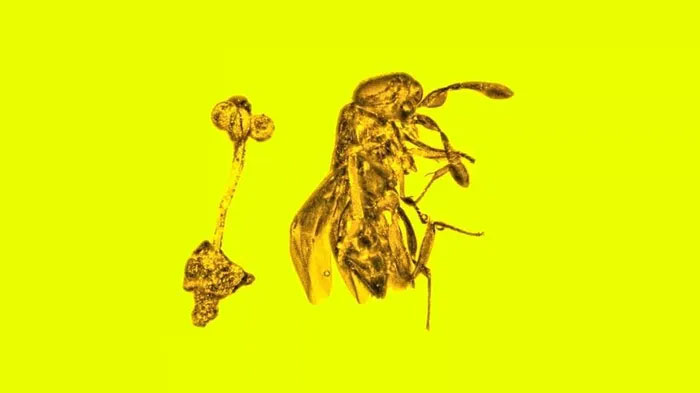A small flower that bloomed 30 million years ago still exists today in nearly perfect condition, preserved within a piece of amber alongside a wasp.
According to a new study published on June 16 in the journal Historical Biology, the discovery of this insect and the flower nearby provides clues about their relationship within the ancient subtropical ecosystem they once inhabited.

Amber flower and wasp
This flower belongs to a previously unknown species within a particularly rare group, and the wasp larva is also a previously unidentified species.
The study’s author, George Poinar Jr., a researcher at the Department of Integrative Biology at Oregon State University in the United States, stated that this insect is also a new species, which he named Hambletonia dominicana, with the species name relating to the Dominican Republic, where the amber was discovered. The parasitic wasp is part of a group known for preying on other insects.
Poinar noted that the graceful shape of the wasp and the position of its perfectly preserved legs make it appear as if it is dancing. Perhaps the wasp was not interested in the flower and simply wandered into the wrong place at the wrong time, resulting in being enveloped by sticky resin.
However, another possibility is that the wasp got stuck near the flower because it was approaching to feed on the pollen.
The flower measures only 2.4 mm and is named Plukenetia minima. It belongs to the flowering plant family Euphorbiaceae, which includes tropical plants such as poinsettias and rubber trees. The oldest fossilized fruits of the Euphorbiaceae family date back to the late Cretaceous period (145 to 66 million years ago). However, fossil evidence of this group is very rare, with only one other known fossil flower from deposits in western Tennessee, USA.
The piece of amber containing the small flower and wasp represents a rare example of fossils that retain significant structural details from when they were alive over 30 million years ago, providing a unique glimpse into the tiny tropical organisms of a distant past, Poinar wrote in the study.


















































